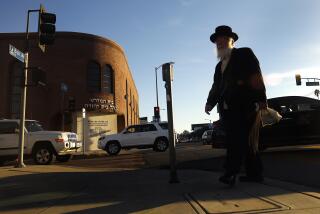Project Draws on Array of Ideas for Synagogue of Future
OJAI â A nationwide project trying to envision the synagogue of the future is drawing on some varied resources--from evangelical mega-churches to Disney executives and film director Steven Spielberg.
The $2.1-million project might also be remembered in the next century for embracing Jewish healing services that are now experimental.
Not that the Synagogue 2000 project, led by a Reform rabbi and an educator in Conservative Judaism, pictures wild-eyed rabbis praying for miraculous healings, creating Judeo-Christian congregations or turning synagogue complexes into mini-theme parks.
Instead, âwe are taking the principle of how ideas work in Disneyland or in churches and applying them to the synagogue,â said Rabbi Lawrence Hoffman, professor of liturgy at Hebrew Union College in New York City.
Hoffmanâs partner in the futuristic effort, Ron Wolfson of Encino, who directs the Whizin Center for the Jewish Future at the University of Judaism, put it this way: âWe are trying to learn from as many sources as possible how to create a welcome place of spiritual nourishment where people can find God in their lives.â
Hoffman and Wolfson co-direct the Synagogue 2000 project, which has selected 16 energetic synagogues to serve as ongoing models for the future. The list is divided evenly between Reform and Conservative synagogues in locations from Boston to Los Angeles.
Among the participants are Temple Isaiah, a Reform synagogue on Los Angelesâ Westside celebrating its 50th anniversary, and 35-year-old Congregation Ner Tamid, a 570-family Conservative temple in Rancho Palos Verdes.
âWe are a fast-growing congregation that gives me, the cantor and the staff a lot of latitude for creative changes,â said Ner Tamidâs Rabbi Ron Shulman.
The Synagogue 2000 project recently took about 60 synagogue leaders from around the country to a service at an evangelical Christian church, Saddleback Valley Community Church in Mission Viejo, to pick up pointers. The Saddleback church attracts 13,000 people each Sunday, making it the fastest-growing Southern Baptist church in the country.
Project leaders also have looked at a large independent church outside Chicago and at Menlo Park (Calif.) Presbyterian Church.
âWe would be in complete disagreement with their religious beliefs, but we are looking at places that generate excitement and community in the midst of a new religious awakening in America,â Hoffman said.
Wolfson attended a Disney-run seminar on customer service, designed for business executives, and was impressed with the hospitality of the hosts, who gave participants small gifts each day or had âbeautiful, long-stemmed roses at every seat.â They are the sort of touches, he said, that synagogue leaders can learn from.
The Spielberg connection is primarily financial. The filmmakerâs Righteous Persons Foundation, supported by his profits from âSchindlerâs List,â is giving $300,000 over three years, as is the Shirley and Arthur Whizin Trust. Another $600,000 is coming from the New York-based Nathan Cummings Foundation, established by the founder of Sara Lee Foods.
The current funding ends in 1998, but representatives of the three foundations said in interviews at a recent Synagogue 2000 meeting at Camp Ramah in Ojai that they may continue financing the project after that.
Rabbi Rachel Cowan, speaking for the Nathan Cummings Foundation, said it is looking to help promote projects encouraging âspirituality,â a broad category that includes Jewish healing services. âSome people are still leery of the word âhealingâ because it sounds Christian or New Age,â Cowan admitted. But the funders agreed that attitudes are changing.
Synagogue 2000 isnât the only Jewish project exploring the value of healing services, which advocates say do not raise expectations for the instant cures touted by some Christian faith healers. Instead, these seek to demonstrate care for the afflicted, pray for strength to endure pain and guide people to spiritual resources.
Reform Judaismâs rabbinical body gave grants last year to five synagogues to develop healing services. One recipient was Temple Judea of Tarzana, where Rabbi Donald Goor said the Nov. 7 service drew 90 people instead of the 40 anticipated.
âSome people are still talking about it, and we plan to have our next one on Jan. 30,â Goor said.
Even Valley Beth Shalom in Encino, a Conservative synagogue whose Rabbi Harold Schulweis is known for his intellectual prowess and wariness of mysticism, is going to add alternative, emotion-filled approaches to its regular worship fare.
Three innovative services will be led in coming weeks by Rabbi Daniel Satlow aimed at young professionals âlooking for a more powerful emotional experience,â and modeled after services at BâNai Jeshurun, a popular synagogue in New York City.
Indeed, the Synagogue 2000 project brought the rabbi and musical director of Bânai Jeshurun to Ojai last month to demonstrate the Shabbat service that draws 1,500 people to Friday night services in Manhattan.
Wolfson said a Web site on the Internet will chronicle changes introduced by the participating 16 congregations as well as lay out creative ideas on music, synagogue design and other techniques to attract members.
The two project directors thus hope to make information quickly available. They also hope to eschew thorny ideological, political or internal synagogue turf problems.
Hoffman and Wolfson said they want new, long-range solutions for creating congregations that will retain adults as members long after their children have completed bar and bat mitzvah ceremonies. They worry about the trend in recent decades toward âpediatric Judaismâ--synagogue affiliation only while the children attend religious school.
âIt used to be different because people had loyalty to their synagogue,â Wolfson said. Another trend, rabbis and lay leaders say, has been for adult Jews to seek spiritual experiences outside of Judaism.
As a result, congregations that once appeared to satisfy members by focusing on broader Jewish community issues are experiencing increased demands for âGod talkâ and personal religious expression--a fact that raises the question that Synagogue 2000 is posing, according to Wolfson: âHow can we create a synagogue as a spiritual center and get that message out?â
Borrowing the language of the marketplace, he added, âWe think we have a great product--weâve been around 3,000 years.â
More to Read
Sign up for Essential California
The most important California stories and recommendations in your inbox every morning.
You may occasionally receive promotional content from the Los Angeles Times.










